开云全站下载构建积极思考如何我们的行业impacts ecology. While reducing the environmental impact of our buildings is critical, we also want to understand how a holistic approach to site development can be used to regenerate degraded ecosystems.
How we changed the Pacific Northwest
西雅图被视为绿色、可持续和手枪eway to outdoor recreation, which makes it easy to overlook that its surrounding environment has been heavily degraded as a result of two centuries of development. Among the most heavily impacted ecosystems are rivers. Dams and levees were constructed to control flooding and facilitate agriculture in floodplains; shorelines were fortified to prevent erosion and protect private land; and an extensive network of roads was built for resource extraction and trade. While these river management practices maximized short-term economic gain and agricultural production, they came at the expense of the abundant fish and wild foods the rivers once hosted. This jeopardizes the future food security of the region; to mitigate this, the restoration of the ecology of rivers, while maintaining their agricultural production, is imperative.
Salmon, the iconic cultural and nutritional resource of the Pacific Northwest, have suffered the most from the modification of our waterways. Fewer than 10% of historic salmon populations remain, several runs are now extinct, and many more are endangered. As migratory species, salmon depend on various ecosystems and rely on freshwater and marine habitats throughout their lifecycle. The health of salmon populations directly correlates with the health of our rivers. Recognizing that healthy salmon and rivers are key components of food security in the region, the restoration of salmon habitat has become a priority.
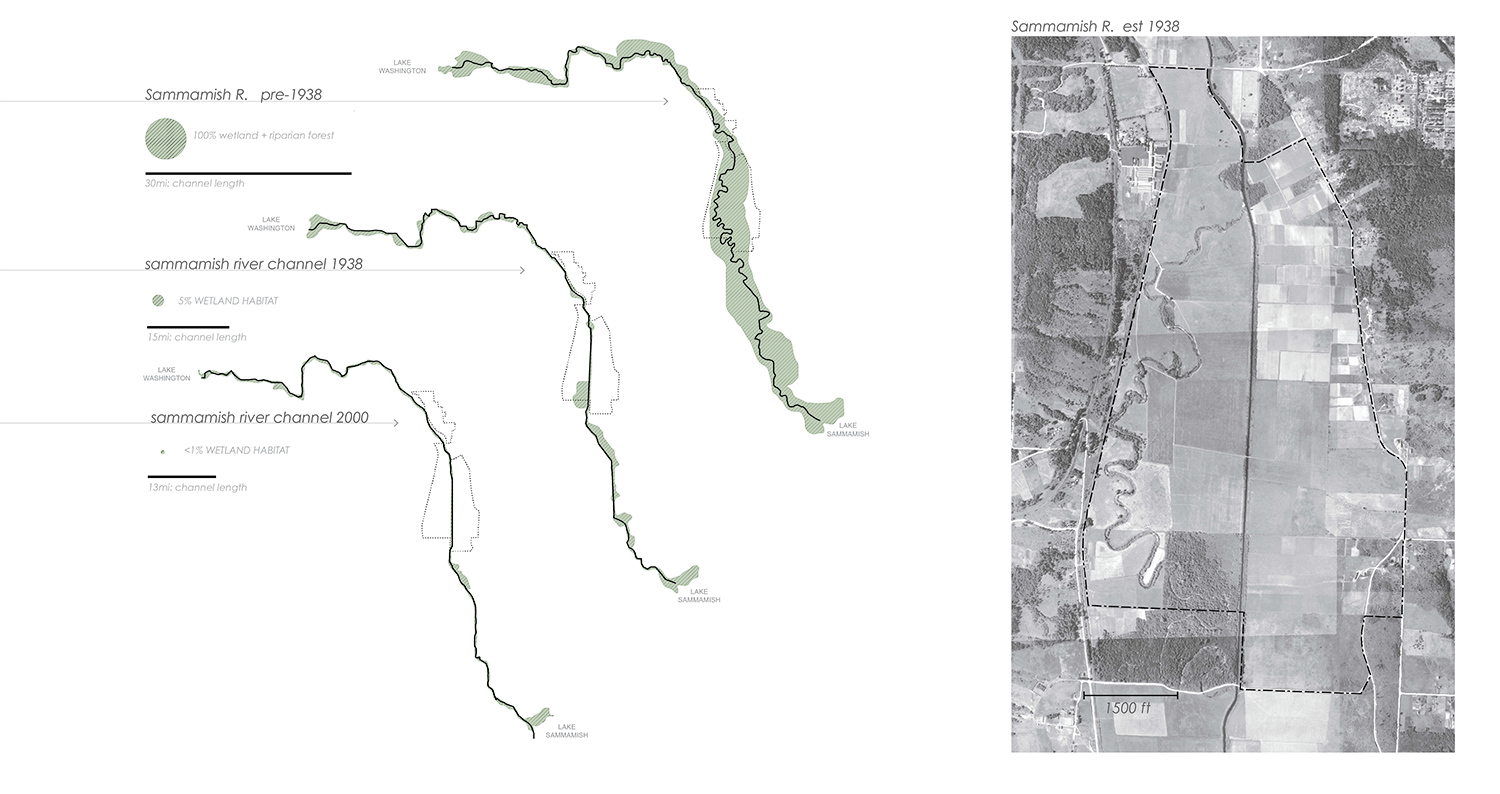
(Left) Change over time of Sammamish river channel. Notice the decrease in habitat as the river was dredged and straightened. (Right) Historic photograph of the Sammamish River. Notice the old meandering channel on the left side of the valley with pieces of riparian forest and wetlands still intact.
Restoring Rivers
修复工作face limitations due to conflicting land uses, particularly in agriculture, which often occupies floodplains and overlaps with critical salmon habitats. Agriculture is economically and nutritionally vital to the region, and many habitat restoration projects require converting agricultural land into wetlands and riparian forests. While ecologically necessary, this places the restoration of rivers at odds with the livelihoods of farmers and the viability of their farms. In Seattle, the Sammamish River Valley, which connects Lake Sammamish and Lake Washington, is exemplary of this conflict.
Like many other waterways across the region, the Sammamish river has been altered and disconnected from its floodplain in order to allow for the development of agriculture. The restoration of this river is critical to enable the recovery of its nearly extinct salmon runs, and efforts are currently underway to improve the heavily degraded habitat. Restoration efforts within this river focus on riparian revegetation and side channel/wetland creation. These are created by re-grading the existing river to maximize wetland habitat, and where possible, directly reconnecting the floodplain to the main channel. These areas are then revegetated with native plants to provide riparian vegetation and wetland habitat.
Due to existing agricultural uses, the total available land area for restoration is only a fraction of the historic habitat. In the Sammamish River, only 5% of historic floodplain habitat could be restored based on current guidelines. To increase the amount of land that could be restored, it would be necessary to find ways to overlap habitat restoration and agricultural land. Preserving agricultural use of floodplains, while also enabling them to serve ecological functions, would allow up to 50% of historical floodplain habitat to be restored in the valley.
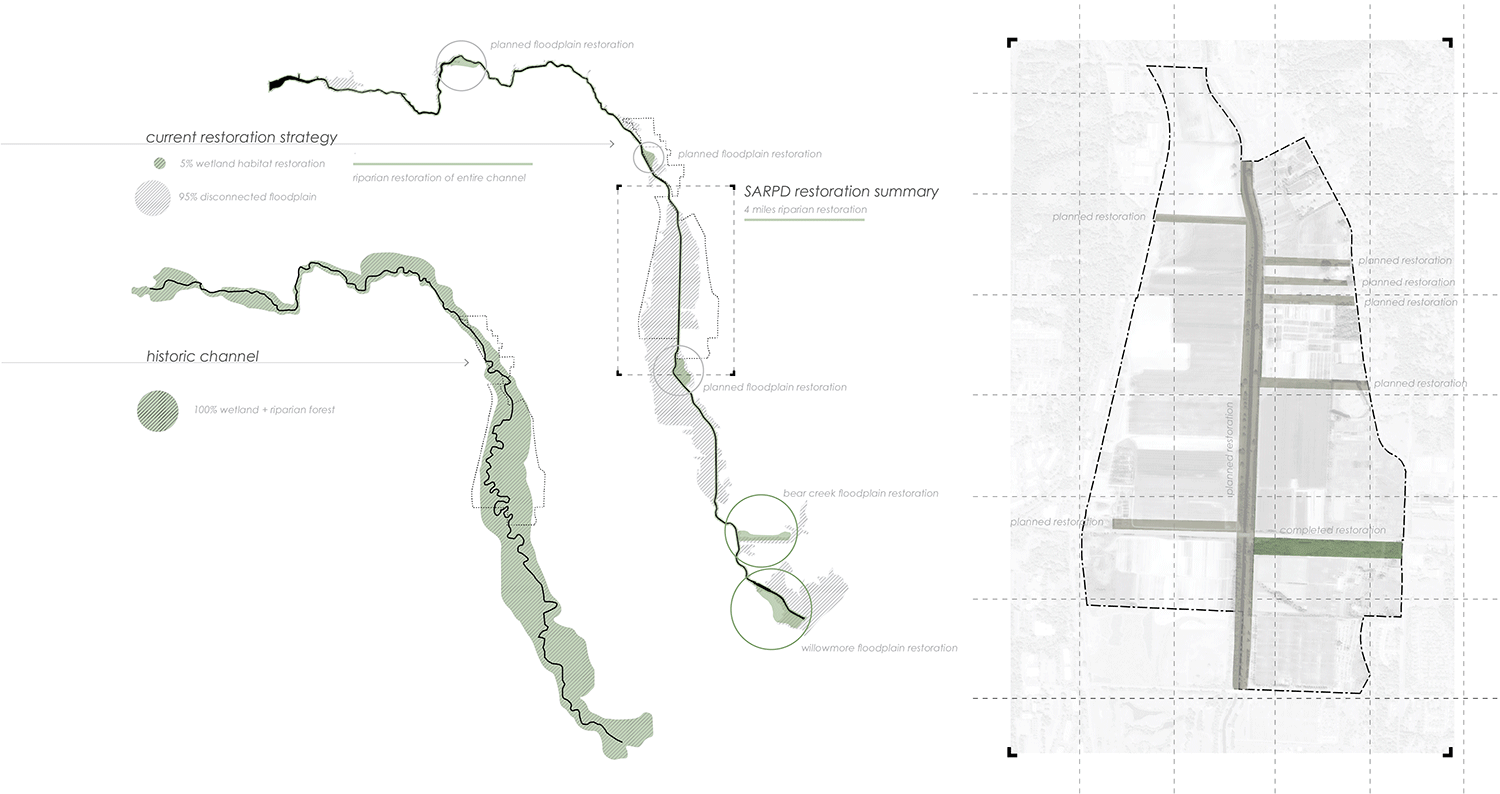
Including agricultural area in the restoration plan of the Sammamish River Valley would increase the potential to restore habitat to nearly 50% of historic conditions
Combining Agriculture and River Ecology
There are several examples of successful overlap between agriculturally productive land and habitat restoration that could be adapted to the Sammamish River Valley. One is the seasonal flooding of rice fields near the Sacramento River, which results in excellent winter nurseries for juvenile salmon, provides important habitat, supports their growth, and increases their chances of survival. The feasibility of growing rice in the Sammamish River is untested, but the same concept of seasonal flooding could be applied to different crops that are already grown in the region. Wild rice (zizania), Cattails (typha), Wapato (sagittaria latifolia) and other edible wetland species could be planted to provide farmers with crops, and salmon with wetland habitat. Another example of the successful integration of agricultural land and habitat restoration is the implementation of agroforestry techniques within riparian buffers, which makes them produce commercially viable crops. Growing moisture tolerant tree species, like walnut (juglans) and hazelnut (corylus) instead of native ones, would create shade and habitat similar to historic riparian forests, but also provide farmers with commercially viable crops.
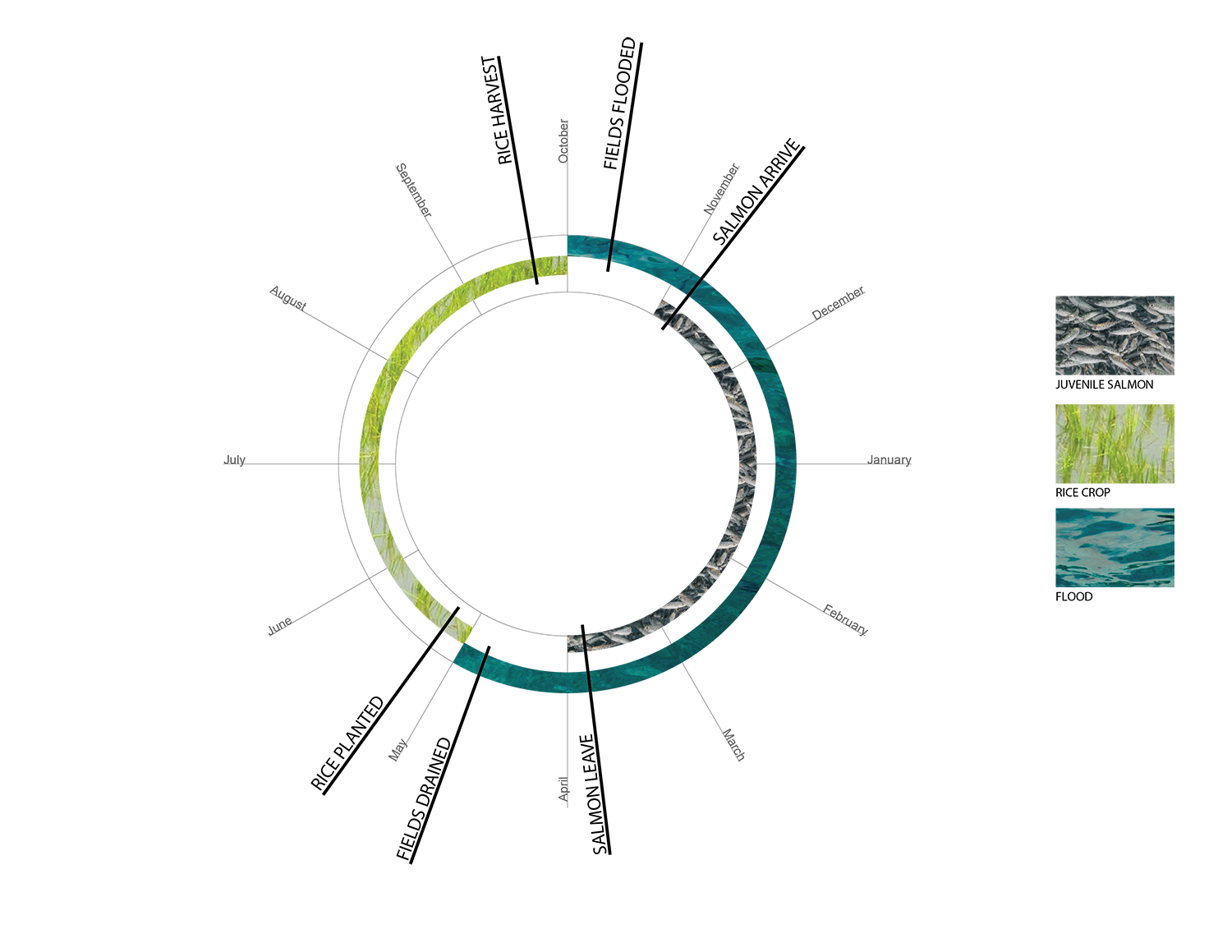
Diagram of salmon and rice sharing time in an agriculturally productive floodplain. Rice is planted in the spring and harvested at the end of the summer. Salmon arrive with the first floods of the season. They spend the winter nursing in the rice fields and continue their migration towards the sea before rice is planted again the following spring.
Building upon the current restoration approach, the river running through agricultural areas could be regraded to create a network of wetlands and riparian forests that could provide habitat and commercially viable crops. There would be a gradient of agricultural uses in the valley: the areas closest to the channel would be managed for the wetland farming of plants like wapato and cattails; and riparian forests would be composed of moisture tolerant and commercially viable trees like hazelnuts and walnuts. As you transition further away from the channel to areas that are less prone to seasonal flooding, techniques like alley cropping and silvopasture could be used to maintain the quality of the soil and prevent erosion, more traditional farms would then create the borders of the floodplain.
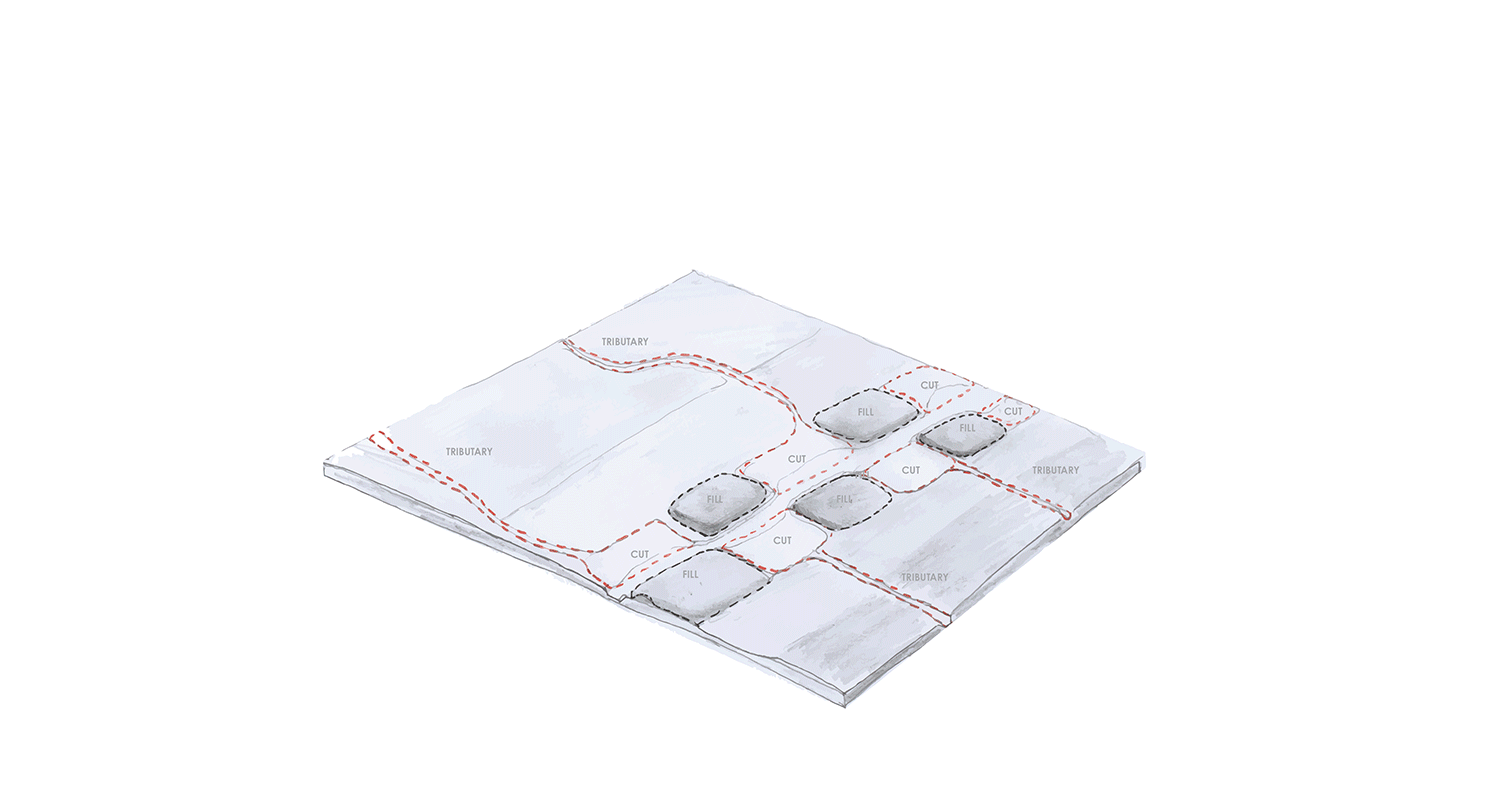
The landscape could be regarded to provide the following agricultural uses: productive riparian wetlands, seasonal forest farming mounds, experimental rice cultivation on the western side of the channel where the topography is lower. The remainder of the floodplain can be used for silvopasture which allows cows to graze in the summer, and can flood during winter storms. Alley cropping can be used to buffer conventional agricultural use outside the 100 yr floodplain zone.
Reintegrating people into the Landscape
This agriculturally and ecologically productive landscape could then be overlaid and connected by a network of ephemeral trails and food hubs. In addition to traveling between farms, this infrastructure would enable the public to gather and process wild goods. It would also improve the economics for farmers by allowing them the ability to process goods like walnuts and cider apples onsite, and then promote and sell their products to the general public. These food hubs would act as sites of connection where farmers, chefs, hunters, gatherers, and the general public could interact and develop a food culture intimately tied to the landscape they inhabit.
As time passes and the river resumes its processes of flooding and erosion, salmon will return to inhabit the landscape. As they complete their life-cycle, they would enrich the land with nutrients they gathered from the sea and add to the already productive agro-ecological system. Such a project could serve as a prototype to test methods and ideas within the realm of ecologically productive agriculture. It would be an opportunity to develop the infrastructure for a landscape that more intimately connects people to food and establishes a new layer of resilience to the region’s valuable resources by providing a future to both farms and salmon.
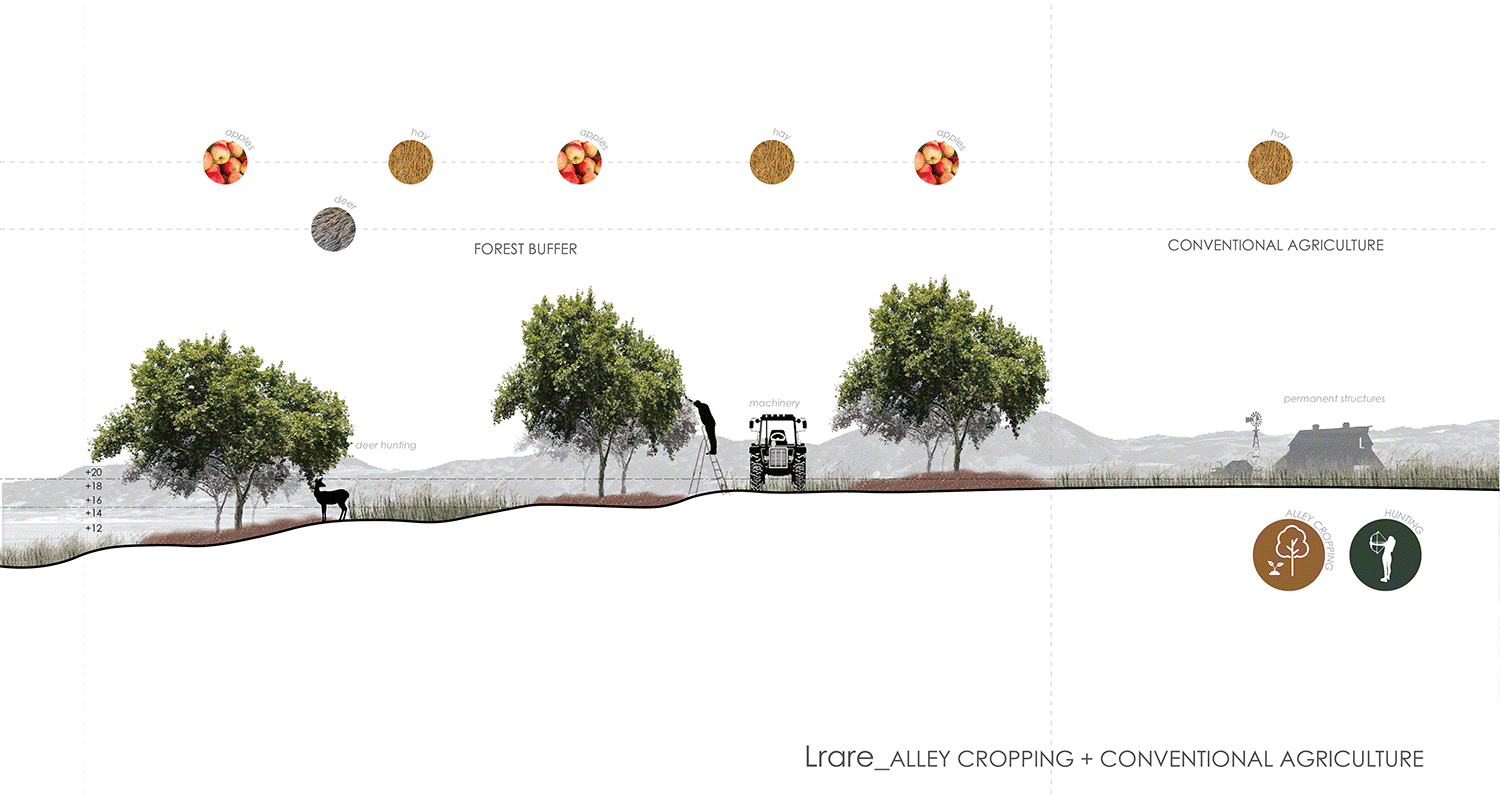
Different agricultural techniques are arranged based on the frequency they will be flooded and their relative moisture levels. (Lrare) rarely floods: alley cropping techniques are used to grow hay for cattle between rows of apple trees and buffer from conventional ag. (Lfunc) floods seasonally, and is used to graze cattle from spring until fall, at the end of the summer nuts are harvested from the trees. During winter this zone floods and provides habitat for juvenile salmon. Deer and other wildlife can be seasonally hunted to manage their populations. (Lmin) is frequently flooded, and connected by an elevated walkway used by the public to explore, hunt, fish, and gather. Food hubs dot this landscape enabling the processing, marketing and selling of goods from the rest of the valley.
Cheers from Team BUILD!






